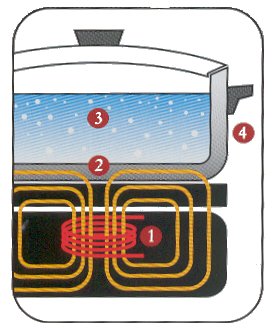Induction cooking has been around for a while, but it seems that in North America it is just beginning to assert itself. I’ve recently learned more about how the technology works from some helpful sites.

At choice.com.au they offer a clear explanation about the magnetic fields:
Each ‘element’ (an induction coil) generates a magnetic field that induces heat in steel cookware placed on top of it. In essence, the pot becomes the element that cooks the food, so the cooktop surface doesn’t get as hot as other cooktops. Induction cooktops have the same instant control as gas and are the fastest of all cooktop types to heat and cook food — for example, they take about half the time of conventional electric cooktops to boil water.
They go on to explain that induction cooktops are smooth surfaces that are extremely easy to keep clean.
Because the heat is contained by the vessel, the cooking surface doesn’t get hot. This picture shows that induction cooking is hot and cool.
Another site, theinductionsite.com, has very thorough explanations of induction cooking and even includes some simple drawings like this one below with clearly labeled descriptions.

How Induction Cooking Works:
- The element’s electronics power a coil that produces a high-frequency electromagnetic field.
- The field penetrates the metal of the ferrous (magnetic-material) cooking vessel and sets up a circulating electric current, which generates heat.
- The heat generated in the cooking vessel is transferred to the vessel’s contents.
- Nothing outside the vessel is affected by the field–as soon as the vessel is removed from the element, or the element turned off, heat generation stops.
(Image courtesy of Induction Cooking World)
As mentioned in point two in the diagram, pots and pans must be made of a ferrous, or magnetic metal. One way to check if your current pans are ferrous is to see if a magnet will stick to them. If your pans do not have a ferrous metal base, you will need to consider the cost of some new cookware along with the generally steep cost of these cooktops. (I found them online for $1,800-$5,000.) There are some induction ranges in the works that can use other metals, but they’re not available yet.
I had concerns about the magnetic fields generated by the coil, and discovered that they are not completely unfounded. People with pacemakers should take precautions near the range and might want to check with their doctors before getting one. Theinductionsite has a whole page dedicated to the controversy surrounding radiation from electromagnetic waves.
There seem to be plenty of both pros and cons to induction cooking- lower energy use saves money, but the cooktop is expensive and may require new cookware. Food cooks more quickly, but new techniques must be learned. The safety of the burner going off automatically if there is no pot on it, but the pots slide easily and could get unintentionally bumped so the food won’t cook. If you are shopping for a new range there is a lot to consider about induction cooking and the choice will be a personal one.